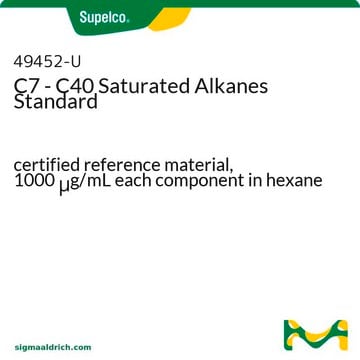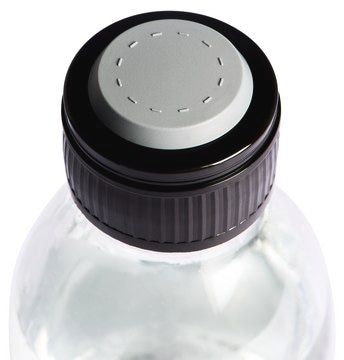256412
1,2,4-Trichlorobenzene
suitable for HPLC, ≥99%
About This Item
Productos recomendados
grado
HPLC grade
Nivel de calidad
densidad de vapor
>6 (vs air)
presión de vapor
1 mmHg ( 40 °C)
Ensayo
≥99%
Formulario
solid or liquid
temp. de autoignición
1060 °F
lim. expl.
6.6 %, 150 °F
técnicas
HPLC: suitable
UV/Vis spectroscopy: suitable
impurezas
<0.020% water
índice de refracción
n20/D 1.571 (lit.)
bp
214 °C (lit.)
mp
16 °C (lit.)
solubilidad
water: insoluble
densidad
1.454 g/mL at 25 °C (lit.)
λ
H2O reference
Absorción UV
λ: 308 nm Amax: 1.00
λ: 310 nm Amax: 0.50
λ: 350 nm Amax: 0.05
λ: 375-400 nm Amax: 0.01
aplicaciones
food and beverages
cadena SMILES
Clc1ccc(Cl)c(Cl)c1
InChI
1S/C6H3Cl3/c7-4-1-2-5(8)6(9)3-4/h1-3H
Clave InChI
PBKONEOXTCPAFI-UHFFFAOYSA-N
¿Está buscando productos similares? Visita Guía de comparación de productos
Categorías relacionadas
Aplicación
- Application of electrospun polyacrylonitrile/Zn-MOF-74@GO nanocomposite as the sorbent for online micro solid-phase extraction of chlorobenzenes in water, soil, and food samples prior to liquid chromatography analysis: This article explores the use of an electrospun polyacrylonitrile/Zn-MOF-74@GO nanocomposite for the extraction of chlorobenzenes, including 1,2,4-Trichlorobenzene, from various samples. The method shows high efficiency and selectivity, making it suitable for environmental and food safety applications (Amini et al., 2021).
- Facile synthesis and immobilization of functionalized covalent organic framework-1 for electrochromatographic separation: This research involves the synthesis and application of a functionalized covalent organic framework for the electrochromatographic separation of various compounds, including chlorobenzenes like 1,2,4-Trichlorobenzene. The method shows potential for analytical and separation sciences (Bao et al., 2021).
Envase
As a global leader in lab reagents, we are constantly looking for new ways to optimize the safety of our products. The newly developed 4L solvent bottle design features advanced sealing technology that eliminates leaks to make the handling of solvents safer and more convenient than ever before.
See all the new features here!
Palabra de señalización
Warning
Frases de peligro
Consejos de prudencia
Clasificaciones de peligro
Acute Tox. 4 Oral - Aquatic Acute 1 - Aquatic Chronic 1 - Skin Irrit. 2
Código de clase de almacenamiento
6.1C - Combustible acute toxic Cat.3 / toxic compounds or compounds which causing chronic effects
Clase de riesgo para el agua (WGK)
WGK 3
Punto de inflamabilidad (°F)
235.4 °F - closed cup
Punto de inflamabilidad (°C)
113.0 °C - closed cup
Listados normativos
Los listados normativos se proporcionan para los productos químicos principalmente. Para los productos no químicos sólo se puede proporcionar información limitada. Si no hay ninguna entrada, significa que ninguno de los componentes está en la lista. Es obligación del usuario garantizar el uso seguro y legal del producto.
EU REACH Annex XVII (Restriction List)
Elija entre una de las versiones más recientes:
¿Ya tiene este producto?
Encuentre la documentación para los productos que ha comprado recientemente en la Biblioteca de documentos.
Los clientes también vieron
Nuestro equipo de científicos tiene experiencia en todas las áreas de investigación: Ciencias de la vida, Ciencia de los materiales, Síntesis química, Cromatografía, Analítica y muchas otras.
Póngase en contacto con el Servicio técnico











